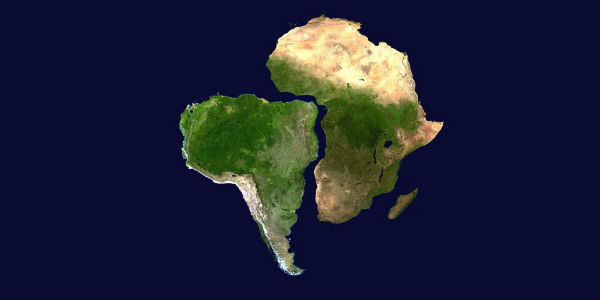
Introduction:
The Earth’s vast and diverse continents hold a myriad of geological mysteries, and among them is the extraordinary resemblance between Africa and South America. As if nature were an artist meticulously crafting a masterpiece, these two continents form a mirror image of each other. This comprehensive article delves into the fascinating geological history, plate tectonics, and the implications of this mirror-image symmetry, unveiling the captivating narrative of how Africa and South America share a deep and ancient connection.
I. Geological History and Plate Tectonics:
- Pangaea and Gondwana: The story begins with the supercontinent Pangaea, a colossal landmass that existed around 335 million years ago. As Pangaea began to break apart due to tectonic forces, the southern part, known as Gondwana, hosted what would later become Africa and South America.
- The Rifting Process: Around 200 million years ago, the process of rifting initiated the separation of Gondwana. Intense geological forces caused the landmass to split along fault lines, creating a gap that would eventually evolve into the South Atlantic Ocean.
- Continental Drift: The concept of continental drift, proposed by Alfred Wegener, gained widespread acceptance as evidence of the Earth’s dynamic nature. This idea became foundational in understanding how continents move and transform over geological time scales.
II. Evidence of a Geological Puzzle:
- Matching Coastlines: One of the most striking pieces of evidence supporting the mirror-image symmetry between Africa and South America is the uncanny resemblance of their coastlines. When aligned, the coastlines fit remarkably well, as if they were once joined together like interlocking puzzle pieces.
- Geological Formations: Beyond coastlines, geological formations on both continents exhibit striking similarities. Mountain ranges, river systems, and geological features align in ways that suggest a shared history and origin.
III. The South Atlantic Ocean:
- Mid-Atlantic Ridge: The Mid-Atlantic Ridge, a continuous underwater mountain range, serves as a tangible marker of the ongoing tectonic activity between Africa and South America. This ridge marks the boundary where the African and South American plates are gradually moving apart.
- Seafloor Spreading: Seafloor spreading, a phenomenon occurring along the Mid-Atlantic Ridge, contributes to the widening of the South Atlantic Ocean. As magma rises from the Earth’s mantle, it solidifies, pushing the existing oceanic crust away and creating new seafloor.
IV. Biodiversity and Paleontology:
- Biogeographic Connections: The mirror-image relationship between Africa and South America has profound implications for biodiversity and biogeography. The similar ecosystems found on both continents, such as the rainforests of the Amazon and the Congo Basin, reflect their shared past.
- Fossil Evidence: Fossil evidence further supports the theory of continental drift. Fossils of identical or closely related species have been discovered on both continents, providing tangible links to a time when Africa and South America were part of a larger, unified landmass.
V. Cultural and Historical Perspectives:
- Indigenous Connections: Indigenous cultures on both continents have ancestral narratives that reflect the interconnectedness of Africa and South America. Shared myths, legends, and cultural practices underscore the enduring bond that transcends geographical distances.
- Colonial Influences: The colonial era witnessed the forced migration of people, plants, and animals across the Atlantic, leaving an indelible mark on the cultures and societies of both Africa and South America. This historical connection further intertwines the destinies of these two continents.
VI. Modern Implications:
- Climate and Ocean Currents: The mirror-image relationship between Africa and South America influences climate patterns and ocean currents. The Atlantic Ocean acts as a conduit for heat transfer and plays a pivotal role in shaping weather systems on both continents.
- Global Trade and Connectivity: The South Atlantic Ocean, once a barrier during the age of sail, is now a conduit for global trade and connectivity. Maritime routes between Africa and South America contribute to the exchange of goods, culture, and ideas, fostering a modern link that echoes their ancient connection.
VII. Future Geological Evolution:
- Continental Drift and Future Changes: The process of continental drift continues to shape the Earth’s surface. While the current movement between Africa and South America is relatively slow, geological forces will inevitably bring about further changes, reshaping coastlines and landscapes in the distant future.
- Scientific Exploration: Ongoing scientific exploration, including advancements in satellite technology and deep-sea research, allows scientists to monitor and study the ongoing geological processes between Africa and South America. These insights contribute to our understanding of Earth’s dynamic evolution.
VIII. Educational Significance:
- Educational Insights: The mirrored relationship between Africa and South America provides educators with a captivating topic for classroom discussions. It serves as an excellent example to illustrate concepts such as plate tectonics, continental drift, and the interconnectedness of Earth’s geological processes.
- Inspiration for Exploration: The geological connection between Africa and South America sparks curiosity and inspires exploration. Students, scientists, and enthusiasts alike are drawn to uncovering the mysteries of our planet’s past and the ongoing processes that shape its future.
IX. Conclusion: A Geological Symphony
In conclusion, the mirror-image relationship between Africa and South America is a geological symphony, echoing the complex and interconnected history of our planet. From the ancient breakup of Pangaea to the ongoing dance of tectonic plates, these continents bear witness to the dynamic forces that mold the Earth’s surface. Beyond the realms of science, this mirrored majesty has left an indelible imprint on biodiversity, culture, and the collective consciousness of those who call these continents home. As we continue to explore, study, and appreciate the intricate dance of continents, the mirror-image bond between Africa and South America remains a testament to the awe-inspiring wonders of our dynamic and ever-evolving planet.